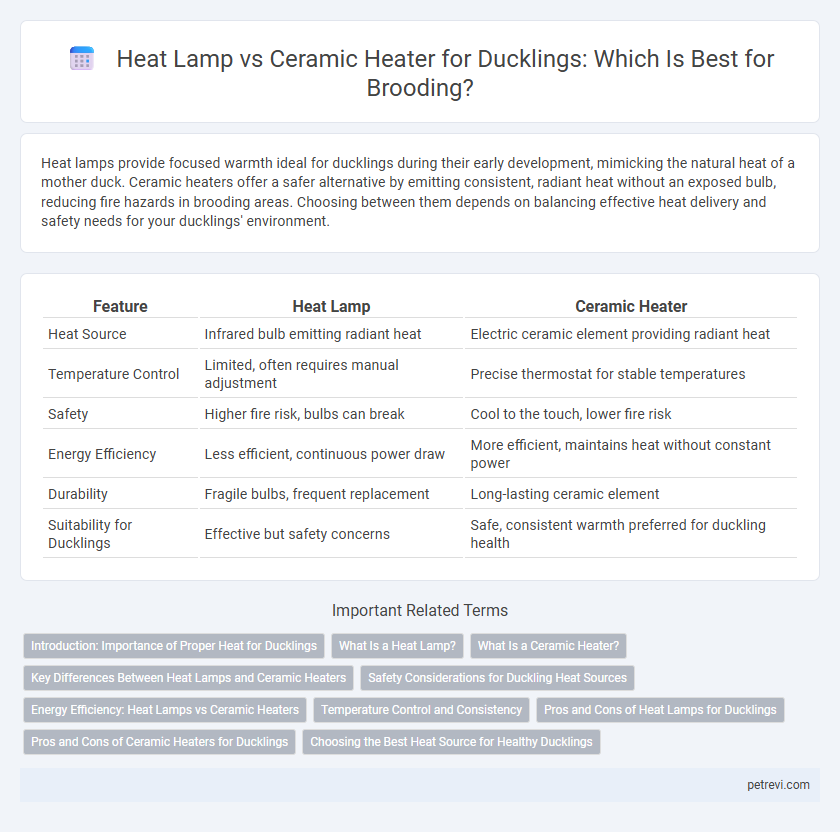Heat lamps provide focused warmth ideal for ducklings during their early development, mimicking the natural heat of a mother duck. Ceramic heaters offer a safer alternative by emitting consistent, radiant heat without an exposed bulb, reducing fire hazards in brooding areas. Choosing between them depends on balancing effective heat delivery and safety needs for your ducklings' environment.
Table of Comparison
| Feature | Heat Lamp | Ceramic Heater |
|---|---|---|
| Heat Source | Infrared bulb emitting radiant heat | Electric ceramic element providing radiant heat |
| Temperature Control | Limited, often requires manual adjustment | Precise thermostat for stable temperatures |
| Safety | Higher fire risk, bulbs can break | Cool to the touch, lower fire risk |
| Energy Efficiency | Less efficient, continuous power draw | More efficient, maintains heat without constant power |
| Durability | Fragile bulbs, frequent replacement | Long-lasting ceramic element |
| Suitability for Ducklings | Effective but safety concerns | Safe, consistent warmth preferred for duckling health |
Introduction: Importance of Proper Heat for Ducklings
Proper heat is essential for the healthy development and survival of ducklings, as they require consistent warmth to regulate their body temperature in early life. Heat lamps provide targeted, radiant warmth ideal for small groups, while ceramic heaters offer a safer, efficient alternative by delivering steady convection heat without open flames. Selecting the right heat source ensures optimal growth, reduces mortality rates, and prevents illness caused by cold stress.
What Is a Heat Lamp?
A heat lamp is a specialized light fixture that emits infrared heat to provide a consistent and focused warmth source for ducklings, mimicking the natural heat from a mother duck. It is designed to maintain an optimal temperature in brooding areas, typically ranging from 90degF to 95degF during the first week of life, gradually decreasing as ducklings grow. Heat lamps are widely used due to their ability to create a warm, safe environment essential for the survival and healthy development of young ducklings.
What Is a Ceramic Heater?
A ceramic heater is an electric device that uses ceramic plates to generate steady, radiant heat ideal for maintaining the optimal temperature in duckling brooding areas. Unlike traditional heat lamps that emit focused infrared light, ceramic heaters provide even, safe warmth without posing a fire hazard or causing stress to young ducklings. This makes ceramic heaters an energy-efficient and reliable option for creating a controlled, comfortable environment essential for healthy duckling development.
Key Differences Between Heat Lamps and Ceramic Heaters
Heat lamps emit intense infrared light to provide targeted warmth directly to ducklings, while ceramic heaters distribute gentle, consistent heat without light, reducing the risk of overheating and fire hazards. Heat lamps often require closer monitoring due to their higher temperature output and potential to cause burns, whereas ceramic heaters offer safer, energy-efficient warmth suitable for extended care. Choosing between the two depends on the need for controlled light exposure and the importance of stable ambient temperature for duckling health.
Safety Considerations for Duckling Heat Sources
Heat lamps pose a fire hazard due to their high temperatures and exposed bulbs, making them less safe around flammable bedding and materials commonly found in duckling brooding areas. Ceramic heaters offer consistent, radiant heat with no exposed elements, reducing the risk of burns and fire while maintaining a stable environment essential for duckling health and growth. Proper installation and regular supervision remain critical to ensure any heat source operates safely and effectively for young ducklings.
Energy Efficiency: Heat Lamps vs Ceramic Heaters
Heat lamps consume more electricity, producing focused infrared heat ideal for small brooding areas, making them less energy-efficient for larger spaces. Ceramic heaters use less power by distributing consistent, ambient warmth without open flames, improving overall energy efficiency and safety. Choosing between the two depends on specific duckling brooding needs, with ceramic heaters offering more economical energy consumption over time.
Temperature Control and Consistency
Heat lamps provide adjustable temperature control crucial for maintaining the ideal warmth of 90-95degF during the first week of duckling care, gradually decreasing as they grow. Ceramic heaters deliver consistent, targeted heat without the risk of fire hazards associated with open bulbs, supporting stable and even warmth critical for duckling development. Precision in temperature control and steady heat distribution directly impact duckling health, reducing stress and promoting proper growth rates.
Pros and Cons of Heat Lamps for Ducklings
Heat lamps provide consistent, adjustable warmth essential for ducklings' early development but pose fire hazards if improperly secured or monitored. Their targeted heat supports optimal growth and energy conservation, yet they can create uneven temperature zones, potentially causing stress or health issues. Compared to ceramic heaters, heat lamps are typically more affordable and easier to install but require careful placement to avoid overheating or burns.
Pros and Cons of Ceramic Heaters for Ducklings
Ceramic heaters provide consistent, dry heat ideal for maintaining a stable temperature in duckling brooding areas, reducing risks of dampness and mold compared to heat lamps. They operate silently and have a longer lifespan, minimizing fire hazards often associated with traditional heat lamps. However, ceramic heaters typically have a higher upfront cost and slower warm-up time, which may not immediately meet the quick heating needs critical for vulnerable ducklings.
Choosing the Best Heat Source for Healthy Ducklings
Selecting the optimal heat source for ducklings is crucial, with heat lamps providing targeted warmth but posing fire risks, while ceramic heaters offer consistent, safer warmth without bright light that can stress ducklings. Understanding the temperature needs of ducklings, typically around 85degF (29degC) during the first week, ensures proper thermal regulation and healthy development. Prioritizing safety and stable heat distribution helps prevent chilling or overheating, promoting robust growth and reducing mortality rates in young ducklings.
Heat Lamp vs Ceramic Heater for Ducklings Infographic

 petrevi.com
petrevi.com